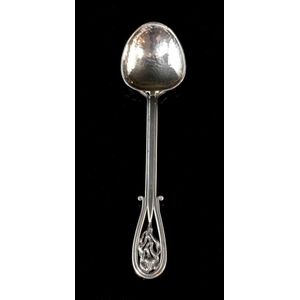Stuart Devlin Hammered Silver Goblets
You must be a subscriber, and be logged in to view price and dealer details.
Subscribe Now to view actual auction price for this item
When you subscribe, you have the option of setting the currency in which to display prices to $Au, $US, $NZ or Stg.
- Assay / Assayed - Assaying is the testing of a metal, most commonly silver and gold to determine its ingredients and quality. In Britain, once an item of silver or gold has been assayed, a mark is stamped on it, certifying its purity. Known as hallmark, it derives its name from the Guild Hall of the Goldsmiths' Company, who recieved its Charter in 1327 giving it the power to assay and mark articles of gold and silver.
- Devlin Stuart - Stuart Devlin was born in Geelong, Victoria, Australia and trained as an art teacher, after which he taught for 5 years and then studied gold and silversmithing, firstly in Melbourne and then at the Royal College of Art in London from 1958. He spent two years at Columbia University where he developed a career as a sculptor.
He returned to his teaching position in Melbourne in 1962 and was appointed Inspector of Art Schools.
In 1963 a competition was held to design the new Australian decimal coinage that was to be introduced in 1966. The new decimal coins were to replace the pre decimal coinage that had been in circulation since 1910. Six competitors vied for the honour of designing these new coins.
Devlin was announced the winner of the competition with designs that featured Australian native fauna on the new coins, with the 1c coin featuring the feather-tailed glider, the 2c a frilled neck dragon lizard, 5c a spiny echidna, the 10c a lyrebird, the 20c duck billed platypus and the 50c Australian Coat of Arms. The 1,c and 2c coins are no longer in circulation. A $1 coin also designed by Devlin and featuring the kangaroo, was introduced in 1984
In 1963 He became involved in the project to design Australia's decimal currency, and during this period he decided to relocate to London and establish himself as a silversmith.
He adapted his knowledge of sculpture into the designs he created for his showroom in Conduit Street in London's West End, which he occupied from 1979 to 1985. His output included limited editions which appealed to longer term collectors, such as Easter eggs and Christmas boxes.
His design skills have extended to furniture, jewellery, clocks, centrepieces, goblets, candelabra, bowls, and insignia.
Following his successful design on Australia's decimal currency, he has designed coins and medals for 36 countries.
He was Prime Warden of the Goldsmith's Company 1996-97 and in 1982 was appointed as goldsmith and jeweller to Queen Elizabeth II and in 1998 he was appointed a member of the Royal Mint Advisory Committee on the Designs of Coins, Medals, Seals and Decorations.
In 2000 he designed 25 coins for the Sydney Olympic Games including the Silver Kilo Olympic Masterpiece, the largest Olympic coin ever made, and the first to show all Olympic sports. He was also awarded an honorary doctorate from RMIT in 2000.
His work is displayed in the Victoria and Albert Museum as well as numerous Australian museums including Powerhouse Museum, Sydney, Museum Victoria and the National Gallery of Victoria.
He was awarded a Companion of the Order of St Michael and St George in the UK in 1980, and an Order of Australia in 1988. - Hammered - A hammered finish on metal wares is achieved by striking the surface of the metal with a hammer to create a series of small, uniform indentations. The indentations can be made in a variety of patterns and depths. The resulting surface texture can vary from a subtle, almost imperceptible texture to a highly textured surface with a strong, pronounced pattern.
The hammered finish adds texture and visual interest to metal objects such as bowls, vases, and other decorative items. It can also be used to add grip or reduce glare on tools, weapons, and other functional metal objects.
A hammered finish can be applied to a range of metals, including copper, brass, silver, and gold. - Sterling Silver - Sterling silver is a mixture of 92.5% pure silver and 7.5% of another metal, usually copper. Fine silver is 99.9% pure silver, and is relatively soft and the addition of the very small amount of copper gives the metal enough strength and hardness to be worked into jewellery, decorative and household objects.
This item has been included into following indexes:
Visually similar items

A pair of South Sea pearl and diamond drop earrings, each earring featuring a flower cluster of round brilliant cut diamonds surmounted by a pave set diamond hook panel, finishing with a long chain drop featuring a round pearl of silver and white hues meas

A pair of 'Dew Drop' earrings by Georg Jensen, each drop set with tumbled prasiolite, in 18ct gold

Four turned brass shop adjustable stands, approx 32 cm high & shorter (4)

A Linton Arts & Crafts silver jam spoon, with banksia finial design, signed JAL 'STG SIL' with gumnut mark. Length 13.2 cm
